 The Avengers in The Veracity Trap!
The Avengers in The Veracity Trap!
Writer: Chip Kidd
Artist: Michael Cho
Publisher: Abrams Comicarts
Publication Date: August 2025
Has there been a time in recent memory where superheroes have evoked actual hope and inspiration more than this summer? Audiences have responded wildly to the optimism and pleas for a better world in both Superman and The Fantastic Four: First Steps, based on two of the most influential comics in the genre’s history. After years where the most imaginative idea people had for the genre was superheroes using their powers for gory debauchery, are superheroes once again inspiring…hope?
The two of the most influential superhero characters, Superman and The Fantastic Four, currently have films out that embody optimism, imagination, and the heroism. So what a perfect time for a book like The Avengers in The Veracity Trap! by Chip Kidd and Michael Cho to come out. While using a very specific era for this specific superhero team, the creators have found a way to create a classic superhero story without it feeling stodgy or made only for genre enthusiasts. This comic embodies an exciting Silver Age optimism but with the sensibilities for a contemporary audience.

The Avengers in The Veracity Trap! embodies a very particular type of Silver Age Marvel story; the one that acknowledges these characters exist in a fictional world. The Avengers while fighting Loki confront a magic Veracity Vortex. This magical creation has them meet… writer Chip Kidd and artist Michael Cho as they work on the very book we’re reading.
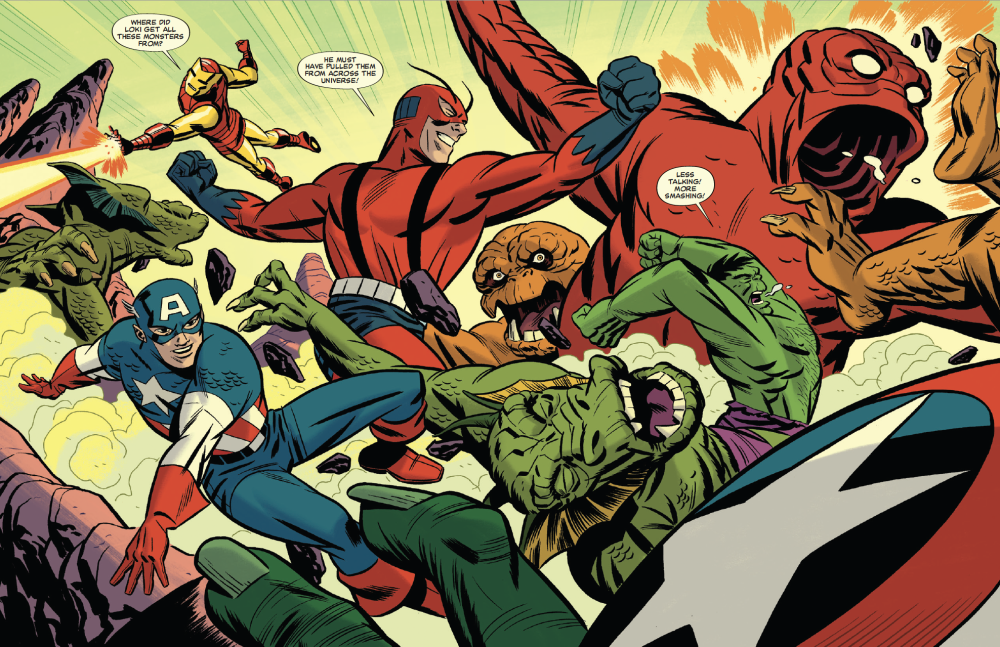
It’s meta and weird. However, this kind of story occurred frequently in early Marvel stories. Take Fantastic Four #10 where Dr. Doom storms into the office of Stan Lee and Jack Kirby or the idea there are Marvel Comics in the Marvel universe. Creators have met their creations throughout comics history.
Kidd and Cho let this idea lead them into a fun möbius strip that becomes this comic. It asks what comes first: the creators having the heroes inspire readers to greater heights or the heroes inspire the creators, who were once readers, to become better people?
The heroes when confronted with their fictional existence become weakened wondering what it’s all for and the two creators become horrified at what they’ve put these heroes through. But both sides embrace the symbiotic relationship that breathes life into any creative endeavor. The heroes strive because the creators demand and the creators thrive because of the example set by the heroes. The Avengers in The Veracity Trap! knows that our relationship with fiction is a two way street.

Yet at the heart of it all, what makes this book special is how it embraces what made Marvel Comics so different when they first appeared and why at their best they resonate so deeply with readers. The script by Kidd is hip and funny but is full of characters who embody the idea that these heroes have vulnerabilities. They’re humans with immense power who do the right thing despite their flaws. Marvel heroes might be down, but they’re never out of a fight.
Most importantly, Cho’s art brings an equal amount of fun and humor to the proceedings. He puts in nods to fun things that appeared in early Marvel books from the fake pin ups to all of the wacky monsters that appeared in the 50s. Fin Fang Foom shows up in his purple pants! Both Goom and his son Googam pop up! Even the Toad Men from Incredible Hulk #2 makes their way into this book. When the characters of Cho and Kidd interact it’s legitimately funny. There’s so many great little character moment in between the action.
Still no matter how many fun easter eggs (and a possible Black Sabbath reference), it’s the storytelling that really allows this story to resonate. Kidd beautifully understands why these characters are great and Cho’s art fully believes in it. When these characters fight, they move like gods. They answer the call to action and give everything they can. When they falter, he gives them pathos. His art reminds us of their humanity and that every now they doubt themselves and what they can do. Their victory feels so real because we’ve seen them come back from their worst.

Maybe the most exciting part of this book though is how formally ambitious it is for a genre that sometimes forgets how malleable the comics medium is. The use of a limited color palette is as much an homage to the genre’s four color origins as it is an expressive tool. Cho uses the visual syntax of superhero comics where elements like double page spreads, Kirby-esque page layouts, and pin ups become a ways to explore the nature of superhero comics themselves. This comic serves as both a knowing homage and commentary to comics that came before him. Cho is a master artist and this is the greatest display of his talent to date.
There is a deep love and appreciation for the stories of early Marvel in this comic. Anything seemed possible in those comics. Not just in the stories being told that could take readers into outer space or to imaginary countries but also in the artistic collaborations that made those stories possible. The superhero genre has seemed so limited in the recent past. The Avengers in The Veracity Trap! wants to remind us that there’s still so much more that our heroes can do.
The Avengers in The Veracity Trap is available now from Abrams Comicsart
And check out the Beat’s most recent comics reviews!


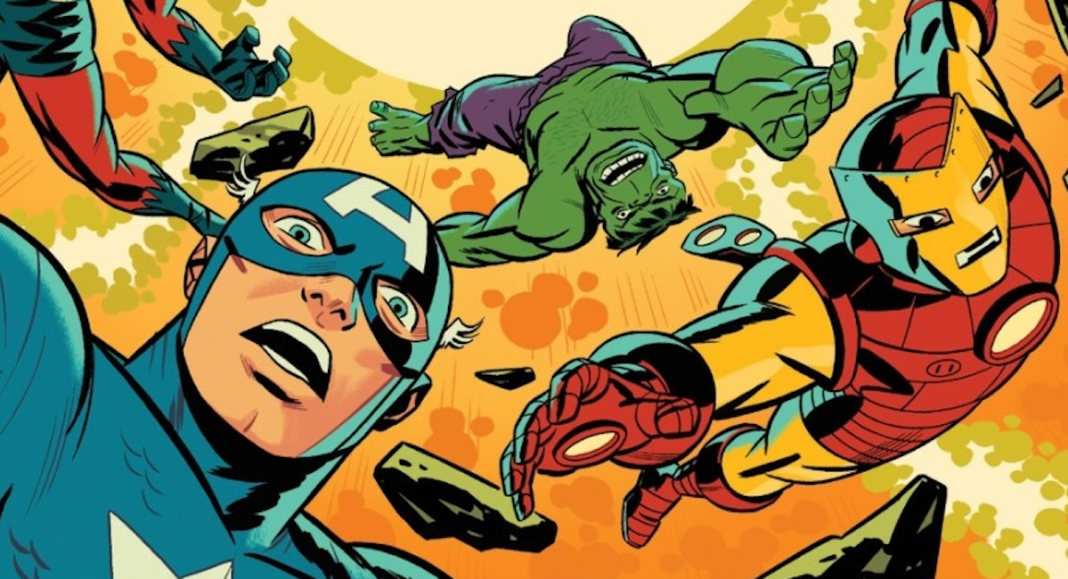
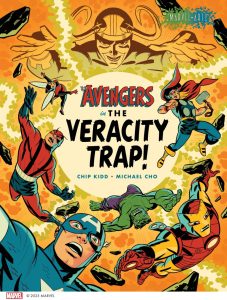 The Avengers in The Veracity Trap!
The Avengers in The Veracity Trap!
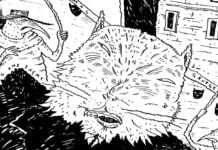

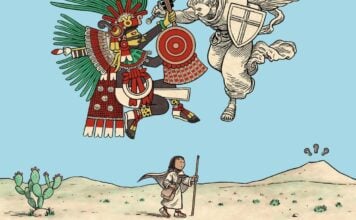





Copy edit:
-“its finest” not “it’s finest”
-“it’s meta” not “It’s a meta”
-“there are Marvel Comics” not “there’s Marvel Comics”
-“what comes first:” not “what comes first;”
-“brings an equal” not “brings and equal”
-“Fing Fang Foom” not “Fing Fang Form”
-“feels so real” not “feels so real complete”
“However, this kind of story occurred frequently in early Marvel stories.”
I loved the artwork (loved, loved, loved it). The story was just…okay. And the quote above pretty accurately captures why: I’ve seen stories like dozens of times before.
Darwyn Cooke also did an homage to the Silver Age in DC: The New Frontier. But unlike this story, that book didn’t feel like a straightforward pastiche. It took the stylistic trappings of the Silver Age but wrapped them around a story that was modern in its structure, themes, and sensibilities. It was narratively ambitious. I wish this book did something similar.
I dislike it when critics fault a work because they don’t like it as much as another work (as I just did above). Each work should be judged on how successfully it achieved what it set out to do. And so, to be fair, the intention was likely for this to be no more than a fun pastiche. And that’s fine. But It just wasn’t that interesting to me.
But again, the artwork is amazing, so buy it for that alone.
You guys desperately need a copy editor. This writer in particular makes a shocking amount of mistakes.
Comments are closed.